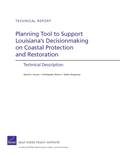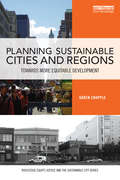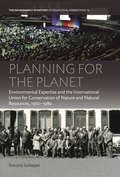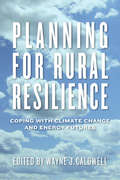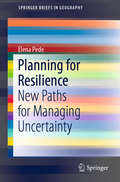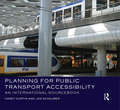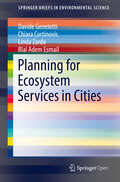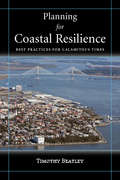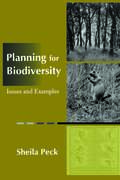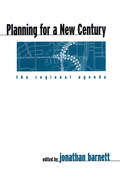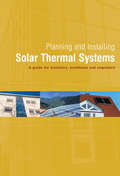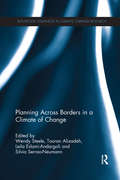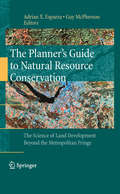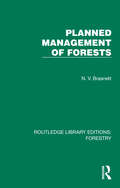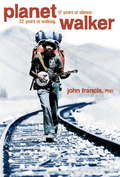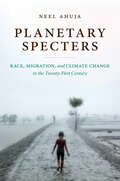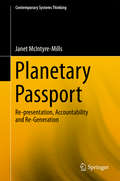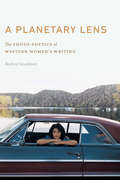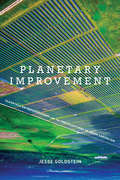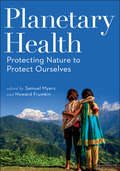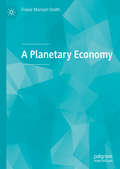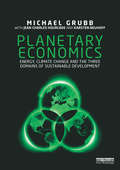- Table View
- List View
Planning Tool to Support Louisiana's Decisionmaking on Coastal Protection and Restoration
by David G. Groves * Christopher Sharon * Debra KnopmanA computer-based decision-support tool, called the Coastal Protection and Restoration Authority (CPRA) Planning Tool, provided technical analysis that supported the development of Louisiana's Comprehensive Master Plan for a Sustainable Coast through CPRA and community-based deliberations. This document seeks to provide an accessible technical description of the Planning Tool and associated analyses used to develop the Master Plan.
Planning Sustainable Cities and Regions: Towards More Equitable Development (Routledge Equity, Justice and the Sustainable City series)
by Karen ChappleAs global warming advances, regions around the world are engaging in revolutionary sustainability planning - but with social equity as an afterthought. California is at the cutting edge of this movement, not only because its regulations actively reduce greenhouse gas emissions, but also because its pioneering environmental regulation, market innovation, and Left Coast politics show how to blend the "three Es" of sustainability--environment, economy, and equity. Planning Sustainable Cities and Regions is the first book to explain what this grand experiment tells us about the most just path moving forward for cities and regions across the globe. The book offers chapters about neighbourhoods, the economy, and poverty, using stories from practice to help solve puzzles posed by academic research. Based on the most recent demographic and economic trends, it overturns conventional ideas about how to build more livable places and vibrant economies that offer opportunity to all. This thought-provoking book provides a framework to deal with the new inequities created by the movement for more livable - and expensive - cities, so that our best plans for sustainability are promoting more equitable development as well. This book will appeal to students of urban studies, urban planning and sustainability as well as policymakers, planning practitioners, and sustainability advocates around the world.
Planning for the Planet: Environmental Expertise and the International Union for Conservation of Nature and Natural Resources, 1960–1980 (Environment in History: International Perspectives #16)
by Simone SchleperIn the 1960s and 1970s, rapidly growing environmental awareness and concern not only led to widespread calls for new policies, but also created unprecedented demand for ecological expertise. This led to novel challenges for advocacy groups such as the International Union for the Conservation of Nature, which had to navigate rival scientific approaches, Cold War politics, and decolonization in their efforts to integrate the study and protection of nature into international policymaking. This book reveals how, despite their vast scientific knowledge and attempts to incorporate socially relevant themes, experts inevitably struggled to make conservation a central part of environmental politics within intergovernmental organizations like the United Nations.
Planning for Rural Resilience: Coping with Climate Change and Energy Futures
by Wayne J. Caldwell Erica Ferguson Emanuel Lapierre-Fortin Jennifer Ball Suzanne Reid Paul Kraehling Eric Marr John Devlin Chris White Tony Mcquail Margaret Graves Bill Deen Ralph Martin Christopher BryantClimate change and an evolving non-renewable energy sector threaten the future viability and sustainability of communities across the country. While rural communities have a special place in the national fabric, they often lack the resources to tackle these important and evolving threats. Planning for Rural Resilience: Coping with Climate Change and Energy Futures makes clear that communities and municipalities have opportunities to make informed and constructive decisions in the face of uncertainty: many of these decisions are “win-win” in the sense that they benefit the community in the short term while also building resilience for the future. Case studies include a town rebuilding itself after a tornado and an individual farmer’s commitment to creating a resilient farm. They provide examples of innovative, successful, and practical on-the-ground actions and strategies. Planning for Rural Resilience asks central questions about the nature of change and the ability to adapt in rural regions. While change is often feared, communities have capacity that can be rallied, harnessed, and turned towards planning policy and action that responds to threats to the future. This important work will assist municipal decision makers, planners, and community members as well as anyone who has a passion for the future and betterment of rural life.
Planning for Resilience: New Paths for Managing Uncertainty (SpringerBriefs in Geography)
by Elena PedeGiven the increasing uncertainty due to catastrophic climate events, terrorist attacks, and economic crises, this book addresses planning for resilience by focusing on sharing knowledge among policy-makers, urban planners, emergency teams and citizens. Chapters look at the nature of contemporary risks, the widespread of resilience thinking and the gap between the theoretical conception and the practices. The book explores how resilience implies a change in planning practices, highlighting the need for flexibility in terms of procedures, and for dynamism in the knowledge systems and learning processes that are the main tools for interaction among different actors and scales. Given its breadth of coverage, the book offers a valuable resource for both academic readers (spatial planners, geographers, social scientists) and practitioners (policymakers, citizens’ associations).
Planning for Public Transport Accessibility: An International Sourcebook
by Carey Curtis Jan ScheurerBringing together a comparative analysis of the accessibility by public transport of 23 cities spanning four continents, this book provides a "hands-on" introduction to the evolution, rationale and effectiveness of a new generation of accessibility planning tools that have emerged since the mid-2000s. The Spatial Network Analysis for Multimodal Urban Transport Systems (SNAMUTS) tool is used as a practical example to demonstrate how city planners can find answers as they seek to improve public transport accessibility. Uniquely among the new generation of accessibility tools, SNAMUTS has been designed for multi-city comparisons. A range of indicators are employed in each city including: the effectiveness of the public transport network; the relationship between the transport network and land use activity; who gets access within the city; and how resilient the city will be. The cities selected enable a comparison between cities by old world–new world; public transport modes; governance approach; urban development constraints. The book is arranged along six themes that address the different planning challenges cities confront. Richly illustrated with maps and diagrams, this volume acts as a comprehensive sourcebook of accessibility indicators and a snapshot of current policy making around the world in the realm of strategic planning for land use transport integration and the growth of public transport. It provides a deeper understanding of the complexity, opportunities and challenges of twenty-first-century accessibility planning.
Planning for Ecosystem Services in Cities (SpringerBriefs in Environmental Science)
by Davide Geneletti Chiara Cortinovis Linda Zardo Blal Adem EsmailThis open access book presents current knowledge about ecosystem services (ES) in urban planning, and discusses various urban ES topics such as spatial distribution of urban ecosystems, population distribution, and physical infrastructure properties. The book addresses all these issues by: i) investigating to what extent ecosystem services are currently included in urban plans, and discussing what is still needed to improve planning practice; ii) illustrating how to develop ecosystem services indicators and information that can be used by urban planners to enhance plan design; iii) demonstrating the application of ES assessments to support urban planning processes through case studies; and iv) reflecting on criteria for addressing equity in urban planning through ecosystem service assessments, by exploring issues associated with the supply of, the access to and demand for ES by citizens. Through fully worked out case studies, from policy questions, to baseline analysis and indicators, and from option comparison to proposed solutions, the book offers readers detailed and accessible coverage of outstanding issues and proposed solutions to better integrate ES in city planning. The overall purpose of the book is to provide a compact reference that can be used by researchers as a key resource offering an updated perspective and overview on the field, as well as by practitioners and planners/decision makers as a source of inspiration for their activity. Additionally, the book will be a suitable resource for both undergraduate and post-graduate courses in planning and geography.
Planning for Coastal Resilience: Best Practices for Calamitous Times
by Timothy BeatleyClimate change is predicted to increase the frequency and magnitude of coastal storms around the globe, and the anticipated rise of sea levels will have enormous impact on fragile and vulnerable coastal regions. In the U.S., more than 50% of the population inhabits coastal areas. In Planning for Coastal Resilience, Tim Beatley argues that, in the face of such threats, all future coastal planning and management must reflect a commitment to the concept of resilience. In this timely book, he writes that coastal resilience must become the primary design and planning principle to guide all future development and all future infrastructure decisions. Resilience, Beatley explains, is a profoundly new way of viewing coastal infrastructure--an approach that values smaller, decentralized kinds of energy, water, and transport more suited to the serious physical conditions coastal communities will likely face. Implicit in the notion is an emphasis on taking steps to build adaptive capacity, to be ready ahead of a crisis or disaster. It is anticipatory, conscious, and intentional in its outlook. After defining and explaining coastal resilience, Beatley focuses on what it means in practice. Resilience goes beyond reactive steps to prevent or handle a disaster. It takes a holistic approach to what makes a community resilient, including such factors as social capital and sense of place. Beatley provides case studies of five U.S. coastal communities, and "resilience profiles" of six North American communities, to suggest best practices and to propose guidelines for increasing resilience in threatened communities.
Planning for Biodiversity: Issues and Examples
by Sheila PeckA significant consequence of the development of natural landscapes is habitat loss and fragmentation that results in widespread loss of biological diversity. While scientists have made great strides in determining principles and concepts fundamental to preserving biodiversity, their work will have little impact unless it is understood and implemented by those who are making on-the-ground decisions about land use.Planning for Biodiversity is an accessible introduction to ecological concepts for planning professionals and students. Sheila Peck explains why planners should be concerned with habitat preservation and presents practical approaches to incorporating conservation principles into planning efforts. The book introduces a clear framework for understanding biodiversity; explains concepts related to ecosystem structure and function; discusses the effects of size and connectivity on habitat quality and species movement; suggests conservation priorities at different scales; presents elements of reserve design; examines types and sources of information; and considers the causes of uncertainty in biodiversity planning and the need for monitoring and adaptive management.In each chapter, Peck presents case studies, including the Beaverhead/Deerlodge National Forest, Montana; Pinhook Swamp Linkage, northeastern Florida; National Gap Analysis Program; CALFED Bay-Delta Program, California; and numerous others, each of which explore the practical implications of the concepts examined. Planning for Biodiversity synthesizes and explains important ecological concepts and is the first guide for planners that clearly details how to incorporate conservation plans into their work. Planners, landscape architects and designers, planning and design students, developers, local officials, and anyone interested in designing and developing more ecologically sound land-use projects will find the book an invaluable resource.
Planning for a New Century: The Regional Agenda
by Jonathan BarnettAcross the United States, issues such as sustainability, smart growth, and livable communities are making headlines. Planning for a New Century brings together leading thinkers in the fields of planning, urban design, education, welfare, and housing to examine those issues and to consider the ways in which public policies have helped create--and can help solve--many of the problems facing our communities. Each chapter identifies issues, provides background, and offers specific policy suggestions for federal, state, and local initiatives. Topics examined include: *the relation of existing growth management policies to social equity, as well as how regional growth management measures can make new development more sustainable *how an obscure technical procedure in highway design becomes a de facto regional plan *ways in which local governments can promote environmental preservation and better-designed communities by rewriting local zoning and subdivision ordinances *why alleviating housing shortages and slum conditions has resulted in a lack of affordable housing, and how that problem can be solved *how business improvement districts can make downtowns cleaner, safer, and more welcoming to workers and visitors In addition, the book features chapters on public safety, education, and welfare reform that include proposals that will help make regional growth management easier as inner-city crime is reduced, schools are improved, and concentrations of extreme poverty are eliminated. Planning for the New Century brings together current academic research with pressing public policy concerns, and will be a useful resource for policymakers at all levels of government, for planners and architects, and for students and scholars of urban planning and design, and urban studies.
Planning Climate And Global Change Research: A Review Of The Draft U.s. Climate Change Science Program Strategic Plan
by Committee to Review the U.S. Climate Change Science Program Strategic PlanThe National Academies Press (NAP)--publisher for the National Academies--publishes more than 200 books a year offering the most authoritative views, definitive information, and groundbreaking recommendations on a wide range of topics in science, engineering, and health. Our books are unique in that they are authored by the nation's leading experts in every scientific field.
Planning and Zoning New York City
by Todd BressiTwo unique events shaped the magnificent unnatural geography of New York City and created its sense of place: the Commissioners' Plan of 1811 and the zoning resolution of 1916. The first imprinted Manhattan with a two-dimensional plan, a rectangular grid defined by broad north-south avenues, multiple east-west cross streets, and by its standard units: blocks of two hundred feet by six hundred to eight hundred feet. The second determined the city's three-dimensional form by restricting uses by district, by limiting the maximum mass of a building allowed on a given site.This book addresses the fundamental challenge facing every American municipality: Can zoning - the basic tool of municipal land-use control - balance growth and equity? As New York plans for the future, the nation's foremost commentators on urban planning, architecture, land-use law, and design discuss the accomplishments of New York's zoning laws and explore alternative scenarios for guiding the city's future development.The chapters in this book were originally prepared for a symposium on the history and future of planning in New York City. The authors provide a skillful blend of urban history, architectural review, economic analysis, and social commentary. Contributors include such experts as Jonathan Barnett, Sigurd Grava, Frances Halsband, Jerold Kayden, Brian Kintish, Eric Kober, Michael Kwartler, Larry Littlefield, Norman Marcus, R. Susan Motley, Richard A. Plunz, Peter D. Salins, Richard L. Schaffer, John Shapiro, Robert A. M. Stern, Roy Strickland, Marilyn Taylor, Robert F. Wagner, Jr., and Carol Willis. This book is essential reading for planners, architects, historians, developers, and municipal officials concerned with guiding the future of America's cities. Its lessons are vital for every city in America.
Planning and Installing Solar Thermal Systems: A Guide for Installers, Architects and Engineers (Planning and Installing)
by German Solar Energy Society (DGS)Solar thermal systems available today offer efficiency and reliability. They can be applied in different conditions to meet space- and water-heating requirements in the residential, commercial and industrial building sectors. The potential for this technology and the associated environmental benefits are significant. This fully updated edition of 2004's bestselling guide offers clear guidance on planning and installing a solar thermal system, crucial to the successful uptake of this technology. All major topics for successful project implementation are included. Beginning with resource assessment and an outline of core components, it details solar thermal system design, installation, operation and maintenance for single households, large systems, swimming pool heaters, solar air and solar cooling applications. Details on how to market solar thermal technologies, a review of relevant simulation tools and data on selected regional, national and international renewable energy programmes are also provided. In short, the book offers comprehensive guidance for professionals who wish to install solar thermal technology and is a highly valued resource for architects and engineers alike who are working on new projects, electricians, roofers and other installers, craftsmen undertaking vocational training and anyone with a specialized and practical interest in this field. Published with DGS
Planning Across Borders in a Climate of Change (Routledge Advances in Climate Change Research)
by Wendy Steele Silvia Serrao-Neumann Tooran Alizadeh Leila Eslami-AndargoliThe fixity or mobility of borders are key themes within the border studies literature and have useful critical application to urban and environmental planning through theory, pedagogy and practice. This offers potential for transformative change through the processes of re-bordering and re-orienting established boundary demarcations in ways that support and promote sustainability in a climate of change. Planning Across Borders in a Climate of Change draws on a range of diverse case studies from Australasia, North and South America, Europe, Africa, the Middle East and Asia and offers the application of border theory, concepts and principles to planning as a critical lens. It applies this lens to a range of international case studies in key areas such as climate change adaptation, food security, spatial planning, critical infrastructure and urban ecology. This collection fills an important gap in the border studies literature, bringing climate change considerations to bear on planning. It should be of interest to students, scholars and professionals in the field of urban and environmental planning, climate change adaptation, border studies, urban studies, human and political geography, environmental studies and development.
The Planner’s Guide to Natural Resource Conservation:
by Adrian X. Esparza Guy McphersonMuch of the country's recent population growth is situated in exurban areas. By many accounts exurbanization has become the dominant pattern of land development in the country and there is no indication it will slow in the foreseeable future (Theobald 2005; Brown et al. 2005; Glennon and Kretser 2005). By definition, exurban development takes place beyond the metropolitan fringe, often in rural and remote areas. The development of new exurban communities is a growing trend, especially in the West. In this case, developers and homebuilders seek large tracts of land, up to thousands of acres, in rural areas (typically within 50 miles of a large city) where they plan entire communities consisting of commercial, retail and residential land uses. Recreational amenities such as golf courses and hiking/biking trails are often included in these master-planned developments. Our philosophy is reflected in the book's two objectives. First, we seek to document the extent and impacts of exurban development across the country. At issue is demonstrating why planners and the public-at-large should be concerned about exurbanization. We will demonstrate that even though exurbanization favors amenity rich regions, it affects all areas of the country through the loss of agricultural and grazing lands, impacts to watersheds and land modification. A summary of environmental impacts is presented, including the loss of wildlands and agricultural productivity, land modification, soil erosion, impacts to terrestrial hydrologic systems, the loss of biodiversity, nonnative and endangered species and other topics. Our second aim is to provide readers from diverse (nonscientific) backgrounds with a working knowledge of how and why exurbanization impacts environmental systems. This is accomplished by working closely to ensure contributors follow a specific outline for each chapter. First, contributors will spell out fundamental concepts, principles and processes that apply to their area of expertise (e.g., riparian areas). Contributors will move beyond a cursory understanding of ecological processes without overwhelming readers with the dense material found typically in specialized texts. For this reason, visuals and other support materials will be integral to each chapter. We have chosen contributors carefully based on their record as research scientists and acumen as educators. Second, once the mechanics have been laid out, authors will explain how and why land development in nearby areas influences ecosystems. Issues of interdependency, modification and adaptation, spatial scale and varying time horizons will be featured. Third, contributors will weigh in on the pros and cons of various land-development schemes. Fourth, authors will share their thinking on the merits of conservation devices such as wildlife corridors, open-space requirements and watershed management districts. Finally, each chapter will conclude by identifying pitfalls to avoid and highlighting "best practices" that will mitigate environmental problems or avoid them altogether. In sum, after completing each chapter, readers should have a firm grasp of relevant concepts and processes, an understanding of current research and know how to apply science to land-use decisions.
Planned Management of Forests (Routledge Library Editions: Forestry)
by N. V. BrasnettOriginally published in 1953, this book was compiled to provide students of forestry with a simple outline of what the management of forests involves, and of the way in which forestry operations are organized and controlled. Topics discussed and explained include economic considerations, stock mapping, topography, climate, soils, form and distribution of crops, scientific forestry, destruction of forests, regulation by volume, area and size and forest protection.
Planetwalker
by John FrancisFrancis' journey began in 1971 when after witnessing an oil spill in San Francisco bay he gave up using motorized transport, and tired of arguing with his friends about whether he was making a difference or not, he gave up speaking. In 1983, in an effort to raise environmental awareness, he set off on foot and in silence across the US and continued to walk for the next 22 years, earning undergraduate and Masters degrees in science and environmental studies and a Ph. D. in land resources along the way. Here he presents the story of his pilgrimage which covered ground from the Pacific to Atlantic coasts, the South American continent from tip to tip, Cuba, and both Alaska and Antarctica. His pen and ink sketches illustrate the margins of practically every page. Annotation ©2009 Book News, Inc. , Portland, OR (booknews. com)
The Planets
by Dava SobelA rich exploration of our solar system--what we know, what we wonder, what we believe.
Planetary Specters: Race, Migration, and Climate Change in the Twenty-First Century
by Neel AhujaNeel Ahuja tracks the figure of the climate refugee in public media and policy over the past decade, arguing that journalists, security experts, politicians, and nongovernmental organizations have often oversimplified climate change and obfuscated the processes that drive mass migration. To understand the systemic reasons for displacement, Ahuja argues, it is necessary to reframe climate disaster as interlinked with the history of capitalism and the global politics of race, wherein racist presumptions about agrarian underdevelopment and Indigenous knowledge mask how financial, development, migration, and climate adaptation policies reproduce growing inequalities. Drawing on the work of Cedric Robinson and theories of racial capitalism, Ahuja considers how the oil industry transformed the economic and geopolitical processes that lead to displacement. From South Asia to the Persian Gulf, Europe, and North America, Ahuja studies how Asian trade, finance, and labor connections have changed the nature of race, borders, warfare, and capitalism since the 1970s. Ultimately, Ahuja argues that only by reckoning with how climate change emerges out of longer histories of race, colonialism, and capitalism can we begin to build a sustainable and just future for those most affected by environmental change.
Planetary Passport
by Janet Mcintyre-MillsThis book explores the implications of knowing our place in the universe and recognising our hybridity. It is a series of self-reflections and essays drawing on many diverse ways of knowing. The book examines the complex ethical challenges of closing the wide gap in living standards between rich and poor people/communities. The notion of an ecological citizen is presented with a focus on protecting current and future generations. The idea is to track the distribution and redistribution of resources in the interests of social and environmental justice. The central argument looks for ways to hold the powerful to account so as to enable virtuous living by the majority to be demonstrated in what the author calls a "planetary passport" - a careful use of resources and a way to provide safe passage to those in need of safe habitat. The book argues that nation states need to find ways to control the super-rich through the governance process and to enhance a sense of shared ecological citizenship and responsibility for biodiversity. The fundamental approach is collaborative research. Planetary Passport: Representation, Accountability and Re-Generation is comprised of six chapters. Chapter 1 begins by making a case for a paradigm shift away from business as usual and the pursuit of profit at the expense of the social and environmental fabric of life. The aim is to explore alternatives and to discuss some ways of achieving wellbeing whilst the focus is on human rights, discrimination and outlining the notion of a planetary passport. Chapter 2 makes a specific link between people and the planet as a basis for understanding the nature of hybridity and interconnectedness and the implications for ethics. Chapter 3 focuses on building this planetary passport for social and environmental justice in order to enable people with complex needs to consider the consequences of either continuing to live the same way as before or making changes to the way that they live. Meanwhile Chapter 4 does the same as the previous chapter, but explores the political context of consumption and short term profit Chapter 5 examines the challenges and opportunities that come from explorations within a cross-cultural learning community. This includes a look at co-creation and co-determination. Finally Chapter 6 ends with a look to the future and a potential new framework for people and the planet through a planetary passport.
A Planetary Lens: The Photo-Poetics of Western Women's Writing (Postwestern Horizons)
by Audrey GoodmanA Planetary Lens delves into the history of the photo-book, the materiality of the photographic image on the page, and the cultural significance of landscape to reassess the value of print, to locate the sites where stories resonate, and to listen to western women&’s voices. From foundational California photographers Anne Brigman and Alma Lavenson to contemporary Native poets and writers Leslie Marmon Silko and Joy Harjo, women artists have used photographs to generate stories and to map routes across time and place. A Planetary Lens illuminates the richness and theoretical sophistication of such composite texts. Looking beyond the ideologies of wilderness, migration, and progress that have shaped settler and popular conceptions of the region, A Planetary Lens shows how many artists gather and assemble images and texts to reimagine landscape, identity, and history in the U.S. West. Based on extensive research into the production, publication, and circulation of women&’s photo-texts, A Planetary Lens offers a fresh perspective on the entangled and gendered histories of western American photography and literature and new models for envisioning regional relations.
Planetary Improvement: Cleantech Entrepreneurship and the Contradictions of Green Capitalism (The\mit Press Ser.)
by Jesse GoldsteinAn examination of clean technology entrepreneurship finds that “green capitalism” is more capitalist than green.Entrepreneurs and investors in the green economy have encouraged a vision of addressing climate change with new technologies. In Planetary Improvement, Jesse Goldstein examines the cleantech entrepreneurial community in order to understand the limitations of environmental transformation within a capitalist system. Reporting on a series of investment pitches by cleantech entrepreneurs in New York City, Goldstein describes investor-friendly visions of incremental improvements to the industrial status quo that are hardly transformational. He explores a new “green spirit of capitalism,” a discourse of planetary improvement, that aims to “save the planet” by looking for “non-disruptive disruptions,” technologies that deliver “solutions” without changing much of what causes the underlying problems in the first place.Goldstein charts the rise of business environmentalism over the last half of the twentieth century and examines cleantech's unspoken assumptions of continuing cheap and abundant energy. Recounting the sometimes conflicting motivations of cleantech entrepreneurs and investors, he argues that the cleantech innovation ecosystem and its Schumpetarian dynamic of creative destruction are built around attempts to control creativity by demanding that transformational aspirations give way to short-term financial concerns. As a result, capitalist imperatives capture and stifle visions of sociotechnical possibility and transformation. Finally, he calls for a green spirit that goes beyond capitalism, in which sociotechnical experimentation is able to break free from the narrow bonds and relative privilege of cleantech entrepreneurs and the investors that control their fate.
Planetary Health: Protecting Nature to Protect Ourselves
by Howard Frumkin Samuel MyersHuman health depends on the health of the planet. Earth's natural systems—the air, the water, the biodiversity, the climate—are our life support systems. Yet climate change, biodiversity loss, scarcity of land and freshwater, pollution and other threats are degrading these systems. The emerging field of planetary health aims to understand how these changes threaten our health and how to protect ourselves and the rest of the biosphere.Planetary Health: Protecting Nature to Protect Ourselves provides a readable introduction to this new paradigm. With an interdisciplinary approach, the book addresses a wide range of health impacts felt in the Anthropocene, including food and nutrition, infectious disease, non-communicable disease, dislocation and conflict, and mental health. It also presents strategies to combat environmental changes and its ill-effects, such as controlling toxic exposures, investing in clean energy, improving urban design, and more. Chapters are authored by widely recognized experts.The result is a comprehensive and optimistic overview of a growing field that is being adopted by researchers and universities around the world. Students of public health will gain a solid grounding in the new challenges their profession must confront, while those in the environmental sciences, agriculture, the design professions, and other fields will become familiar with the human consequences of planetary changes. Understanding how our changing environment affects our health is increasingly critical to a variety of disciplines and professions. Planetary Health is the definitive guide to this vital field.
A Planetary Economy
by Fraser Murison SmithThis book asks, how would a stable, prosperous economy of the future look if one started with a blank sheet of paper? Given that the world’s economy is locked into a coevolution with nature, the urgency of this question is brought into stark relief by the 2020 coronavirus pandemic and ongoing climate change. While physical technologies to build such an economy mostly exist, the social technologies, in the form of institutions, governance and policies, do not. The development of these social technologies will necessitate a reconsideration of economic norms: in particular, what is the economy for, and what are we, as actors within it, striving for? This book integrates normative, institutional, political and economic requirements into a systematic framework to drive our present growth economy toward a future planetarian one. It outlines a suite of interrelated policies to increase the economy’s material efficiency, establish a basic living standard, and reform the money system, while along the way eliminating economic debt and balancing government budgets. The framework and policies together form a paradigm of market planetarianism: the idea that the power of markets may be used to steer the economy toward a desired long-term goal. The methodological aspects of this paradigm are covered in the companion volume, Economics of a Crowded Planet.
Planetary Economics: Energy, climate change and the three domains of sustainable development
by Michael GrubbHow well do our assumptions about the global challenges of energy, environment and economic development fit the facts? Energy prices have varied hugely between countries and over time, yet the share of national income spent on energy has remained surprisingly constant. The foundational theories of economic growth account for only about half the growth observed in practice. Despite escalating warnings for more than two decades about the planetary risks of rising greenhouse gas emissions, most governments have seemed powerless to change course. Planetary Economics shows the surprising links between these seemingly unconnected facts. It argues that tackling the energy and environmental problems of the 21st Century requires three different domains of decision-making to be recognised and connected. Each domain involves different theoretical foundations, draws on different areas of evidence, and implies different policies. The book shows that the transformation of energy systems involves all three domains - and each is equally important. From them flow three pillars of policy – three quite distinct kinds of actions that need to be taken, which rest on fundamentally different principles. Any pillar on its own will fail. Only by understanding all three, and fitting them together, do we have any hope of changing course. And if we do, the oft-assumed conflict between economy and the environment dissolves – with potential for benefits to both. Planetary Economics charts how.
